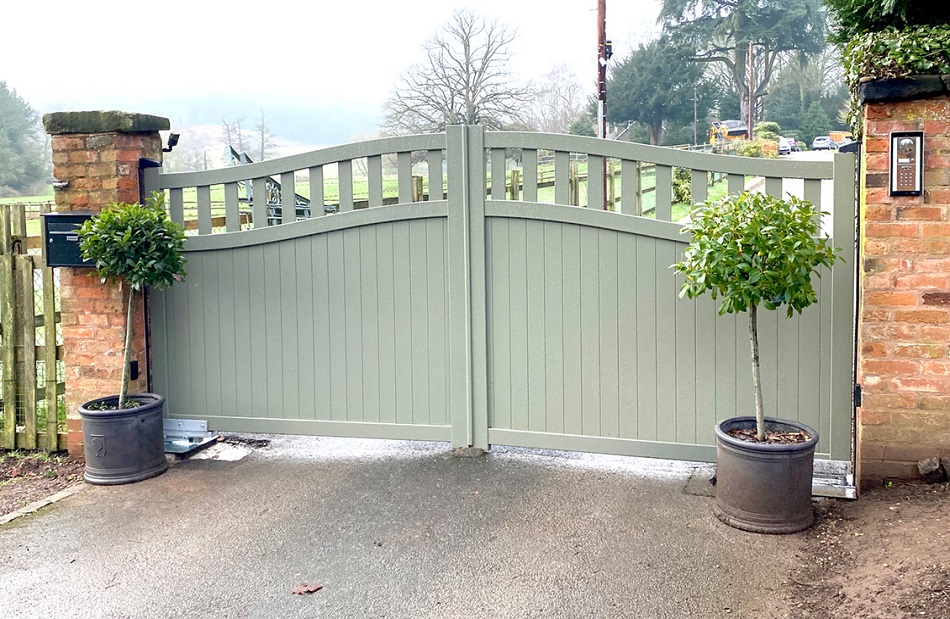Here at Wrought Iron Gates Direct, we’ve seen that compared to other gate types, driveway gates aren’t as easy to spot when something goes wrong. Instead, the deterioration is gradual through small, 'easy-to-ignore' changes until something actually breaks.
The trick is catching issues before they escalate. So, for example, a sticking latch that gets forced daily will eventually damage the gate frame. Hinges that squeak for months will wear through and fail completely. What starts off as a minor irritation becomes an expensive repair job.
November is the worst time of the year for gate problems to develop. You're coming into winter when access is more important: the bins need collecting, there will be deliveries, and vehicles need parking. A gate that's "managing" now, will struggle more through December and January.

Here are five signs that professional attention is needed sooner rather than later.
1. The Gate's Dropped and Won't Close Properly
This is probably the most common issue we see and encounter here at Wrought Iron Gates Direct. We often hear that the gate can gradually drop on its hinges over months or years. Eventually then it catches on the ground or doesn't meet the latch properly.
You'll start to notice the gap at the top is getting wider, or the bottom edge begins to scrape. Or that latch that used to engage perfectly now misses by half an inch. A lot of people try to compensate for this by lifting the gate while closing it; that is just increasing the rate of damage.
This drop happens because hinge pins wear, or because fixings work loose, or posts move. And sometimes it's all three at once. Working out which is the actual cause requires experience that most homeowners don't have unfortunately.
Our advice would be - Don't force dropped gates; you are putting stresses on components they're not made to take. Get someone out to diagnose it properly, and sometimes it is just a simple adjustment of the hinge. Sometimes it reveals other, bigger problems that need addressing.
2. Automatic systems that behave erratically
Gates should run smoothly and reliably. When they suddenly start becoming unpredictable, stopping mid-cycle, or even reversing for no apparent reason, or responding only occasionally to controls, something is wrong with the system.
These problems often worsen in cold or damp weather. Electronics do not like moisture. Safety sensors get confused by temperature changes. Motors struggle when mechanisms are cold.
The problem could be mechanical instead of electrical. Gates that are binding slightly create extra load on motors, which in turn trip safety cutouts and stop operation. Sometimes the gate works because conditions vary: Temperature affects how much binding occurs.
This is most apt to happen with track-mounted sliding gates. Leaves, dirt, or slight ground movement affects the smoothness of the gate's travel. The motor compensates up to a point until the whole system begins to fail intermittently.
Here's the problem with erratic automated gates: they are dangerous. Safety systems that operate unpredictably can't be trusted. Gates that stop randomly may trap someone or something. You absolutely need professional diagnosis when automation starts misbehaving.
DIY fixes often have a tendency to make things worse. Without knowing why the sensors are tripping, adjusting them causes new problems. Forcing mechanical issues places undue strain on motors. Automated gate systems integrate multiple components, and fixing one part without addressing root causes rarely works.
3. Visible Rust or Corrosion in Critical Areas
A little surface rust on the gates is of little consequence. A little corrosion on non-structural or purely decorative elements can wait. But rust in some locations points out serious problems developing.
Inspect the welds and joints. Any rust there reduces structural integrity. Pay close attention to hinge mount points. Corrosion around fixings means moisture has penetrated. It weakens everything. Of special concern is an automated gate's track mechanism, as rust here causes binding and motor damage.
The concerning thing about rust is not always what you can see. Surface corrosion indicates moisture has breached protective coatings. Once that happens, corrosion progresses beneath the surface faster than it shows externally.
The metal posts that have reached the ground level must be replaced immediately. This is because this is very much like timber post rot-once it starts at the base, the whole thing becomes compromised. You can't tell how far corrosion is internally without proper inspection.
Rust most frequently makes a sudden appearance in the autumn as the summer drying out period ends. Thus, gates that look fine in September can show considerable corrosion by November. That rapid appearance usually means the problem started earlier but protective coatings were hiding it.
Treatment depends upon severity and location: minor surface rust can be treated and recoated, while structural corrosion often requires component replacement. Working out which is which needs professional assessment. Get it wrong and you're either wasting money on unnecessary replacement or risking failure of inadequately repaired components.
4. Strange Noises During Operation
Gates should make no more noise than the ordinary sounds of machinery. New noises indicate that something has changed-and not for the better.
Squeaking usually means the lubrication has broken down. Sounds simple, but it reveals that moisture has displaced lubricant. That moisture is now causing wear where lubricated surfaces should be protected. Ignoring squeaks accelerates hinge wear dramatically.
Grinding or scraping suggests metal-on-metal contact or timber rubbing where it shouldn't. Both cause progressive damage: the grinding sound is literally the components wearing away.
Creaking indicates movement in joints which should be solid. Timber gates with loose joinery develop characteristic creaks. Metal gates creak when welds or fixings have failed. Neither is something to ignore.
Rattling means something's loose. Could be minor-a fixing that needs tightening. Could be significant-a structural component that's failed. You can't really tell without investigation.
Clicking or ticking from automated systems usually signals electrical or mechanical problems with operators. Motors making unusual noises are carrying loads they shouldn't; that's expensive damage developing.
The thing about noises is they normalise quickly. You stop noticing the squeak after a few weeks. But the damage keeps accruing regardless of whether you're hearing it anymore. When gates start making sounds they didn't before, get someone to look at them.
5. Difficulty Operating That's Getting Progressively Worse
Gates should swing with consistent effort. If it gets harder to open or close over time, something's deteriorating.
It does so gradually enough that you adapt without realising it. You start using two hands instead of one. You brace yourself differently. You develop a technique for getting the gate to engage properly. Then one day you can't manage it at all.
Where there is progressive difficulty, there are usually multiple issues. Hinges wear, posts move, frames distort-all create incremental resistance. Each problem compounds the others.
Seasonal variation is normal to a certain extent: gates operate slightly differently in summer compared with winter. However, progressive worsening through one season indicates real, rather than normal variation.
Progressive power loss in automated gates implies that motors are struggling due to increased loads, brought about by the development of mechanical problems that motors can no longer compensate for. By the time you notice power loss, the motor has been working overtime for months.
Latches that used to engage easily but now require precise positioning indicate alignment problems. The gate hasn't just dropped – it's also twisted, or the posts have moved relative to each other. These are problems that worsen rapidly once started.
When to Call Professionals Rather Than DIY
Some gate issues are well-suited for do-it-yourself applications: lubrication, minor cleaning, or tightening loose fasteners-are all reasonable tasks for competent homeowners. However, the five signs above indicate problems beyond simple maintenance.
Professional assessment might be a cost upfront but saves money on early detection of problems. The gate company can diagnose whether dropping is just a simple hinge adjustment or indicates a case of post failure; they can diagnose if automation problems are sensor calibration or motor replacement. They recognise the corrosion patterns that reveal how far the damage extends.
Another advantage of professional attention is proper repair. Botched DIY fixes often create additional problems. Posts repaired incorrectly fail sooner. Automated systems adjusted improperly become dangerous. Rust treatment done inadequately accelerates rather than prevents further corrosion.
The timing of this is important specifically for November. Issues caught now can be fixed before winter is putting maximum stress on the gates. Problems left until January usually become emergencies and cost more while taking longer to address.
If you see any of these five signs within your driveway gate, get professional assessment before winter arrives properly. What might seem to be a little issue right now will be a huge problem by February. Prevention really does cost less than repair in gate maintenance. And if you’re looking for brand new driveway gates – be sure to visit our online catalogue to buy online today.



